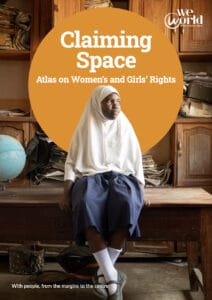
In Kenya, being born a woman or a girl often means starting life from a position of disadvantage. It means…
Read moreCase Studies on Natural Resource use, Waste Management and the circular Economy Practices in Kwale, Nairobi and Isiolo, and County
As part of the Sikiliza Sauti Yetu: Dunia Inaita! project, funded by the European Union, WeWorld, alongside partners Barnfonden, Organization of African Youth Kenya (OAY-K), and CRAWN Trust, recently carried out three in-depth case studies across Kwale, Nairobi, and Isiolo counties. These studies spotlight grassroots efforts in natural resource management (NRM) in Kwale County; management in informal settlements in Nairobi County and children as stewards of environment protection and conservation in Isiolo County.
1. Kwale County – Women Restoring Mangroves
Our team visited the Gazi Women Mangrove Boardwalk Community-Based Organization (CBO), a group of 22 women who are transforming their coastal community through environmental conservation, eco-tourism, and climate advocacy. The Gazi Women Mangrove Boardwalk CBO is restoring coastal ecosystems through mangrove planting, eco-tourism, and carbon trading. Over One Million mangrove trees have been planted, offering both environmental and economic benefits. Despite limited funding and weak policy support, these women are changing the tide through leadership, education, and innovation.
Since its formation, the CBO has planted over 1 million mangrove trees, constructed a 350-meter boardwalk for eco-education, and developed income-generating activities like guided tours, cultural experiences, and local crafts. Our case study highlights the challenges they face, such as declining tourism, limited funding for expansion, and lack of policy frameworks that explicitly support women in Natural Resource Management (NRM). Yet, their resilience is inspiring. Their work is internationally recognized and contributes to global climate goals through carbon trading under the Mikoko Pamoja initiative.
2. Nairobi County – Youth Tackling Urban Waste
In the informal settlement of Mukuru kwa Reuben, Ubuntu Youth CBO is turning waste into opportunity. From clean-up drives and eco-sanitation to rabbit farming using kitchen waste, these young changemakers are championing the circular economy. Their story highlights the urgent need for policies that support youth-led green enterprises and better infrastructure for informal settlements.
3. Isiolo County – Children as Environmental Stewards
At Elsa Comprehensive Primary School and the Isiolo School for the Deaf, students are growing vegetables, keeping livestock, and learning about sustainability through 4K Clubs. These efforts, guided by dedicated teachers, are turning schools into hubs of climate education. However, gaps in county policies limit the reach of these initiatives.
Each case study showcases a unique, community-driven response to climate challenges and emphasizes the need for inclusive policies, targeted funding, and capacity building to amplify these efforts.
In Kenya, being born a woman or a girl often means starting life from a position of disadvantage. It means…
Read moreClaiming Space, our third Atlas, shows how women and girls around the world are claiming their spaces and shaping their…
Read moreOn Our Lands, On Our Bodies is a research project that sheds light on a connection that remains underexplored yet increasingly…
Read more

